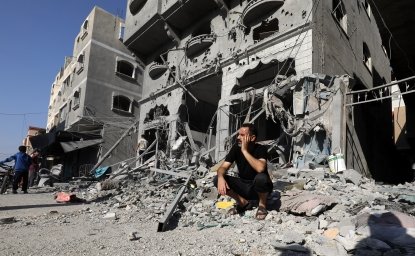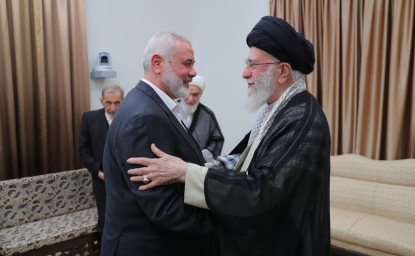By Cameron Glenn
Al Qaeda and ISIS - also known as ISIL, Daesh, or the Islamic State - differ in their leadership structure and how they manage daily operations. The two rival jihadist groups share the goal of forming a global caliphate. But ISIS claims its organization achieved that goal in 2014, whereas al Qaeda views the caliphate as a long-term objective.
Leaders
Al Qaeda founder Osama bin Laden used charisma, fatwas and rhetoric to rally jihadists around the world. ISIS leader Abu Bakr al Baghdadi has been a mysterious figure who rarely appeared in public after ISIS announced its caliphate in 2014. ISIS has used ruthless violence to exert power.
Al Qaeda
ISIS
Ayman al Zawahiri
Zawahiri was born in Cairo in 1951 to a middle class Egyptian family. He was trained as a doctor, but became active in Islamist groups during his teenage years. In 1973, he joined Islamic Jihad, an armed jihadist group calling for the overthrow of the Egyptian government. In 1981, he was imprisoned in connection with the assassination of Egyptian president Anwar al Sadat. He left Egypt for Pakistan in 1985 to help jihadists fighting Soviet forces in Afghanistan. In 1998, he joined forces with Osama bin Laden.
Zawahiri became al Qaeda’s main ideologue and most prominent spokesperson throughout the 2000s. He took over the leadership of al Qaeda in 2011, after bin Laden was killed.
Abu Bakr al Baghdadi
Baghdadi was born in Samarra in 1971. He reportedly received jihadist training in Afghanistan in the late 1990s, when he lived with Abu Musab al Zarqawi in Kabul. He fought with jihadists in Fallujah in the early 2000s after returning to Iraq, and was reportedly held at the U.S. detention facility Camp Bucca from February to December 2004. In 2010 he assumed leadership of ISIS, then called the Islamic State of Iraq. Little else is known of his background, but jihadist publications claim that he is from a religious family descended from noble tribes, and that he holds a PhD from Baghdad’s Islamic University.
Baghdadi is known for avoiding the spotlight. There are only two known photos of him, and he reportedly conceals his identity with a bandanna from everyone outside his small inner circle.
Structure
Al Qaeda does not directly manage the daily operations of its franchies. ISIS, however, claims to have direct control over the fighters and residents in its territory.
Al Qaeda
ISIS
Unlike ISIS leader Abu Bakr al Baghdadi, Zawahiri does not claim to have direct hierarchical control over al Qaeda’s vast, networked structure. Al Qaeda’s core leadership seeks to centralize the organization’s messaging and strategy rather than to manage the daily operations of its franchises. But formal affiliates are required to consult with al Qaeda’s core leadership before carrying out large-scale attacks.
Al Qaeda’s core leadership includes a shura council, as well as committees for military operations, finance, and information sharing. Al Qaeda leaders communicate with affiliated groups through their respective information committees.
Other key figures
Nasser al Wuhayshi, leader of al Qaeda in the Arabian Peninsula and second-in-command in al Qaeda’s core leadership. Wuhayshi was reportedly killed in a U.S. drone strike in June 2015, and replaced by Qasim al Raymi.
Abu Mohammed al-Joulani, head of the Nusra Front in Syria and former member of al Qaeda in Iraq.
Mansoor al Harbi, a key trainer and logistician based in Afghanistan. The Saudi press reported in 2015 that he had been killed by a U.S. airstrike.
Farouq al Qahtani al Qatari, a commander based in the Kunar province of Afghanistan.
Khalid al Habib, a field commander in southeast Afghanistan.
Baghdadi is the supreme political and religious leader in ISIS territory. The caliph has virtually unchecked authority, but in practice he relies on deputies like Abu Muslim al Turkemani, who oversees ISIS areas in Iraq, to manage administration of its territory. The Islamic State has a Shura Council that can theoretically depose the caliph, but all members are appointed by Baghdadi.
ISIS leadership has direct command and control over its fighters in Iraq and Syria, though its ability to direct its affiliates abroad is unclear. In March 2015, ISIS affiliates claimed responsibility for the Bardo Museum attacks in Tunis and the mosque attacks in Yemen, but U.S. officials were skeptical of the extent to which the attacks were coordinated by ISIS leadership in Iraq and Syria.
The upper echelon of ISIS leadership includes Baghdadi’s advisers, his deputies for overseeing operations in Iraq and Syria, and the shura council – which technically has the authority to depose Baghdadi. ISIS also has a sharia council, as well as councils responsible for security, military affairs, media, and finance.
Other key figures
Abu Muslim al Turkemani, also known as Fadhil Ahmad al-Hayali Baghdadi’s deputy who oversaw operations in Iraq. He was reportedly killed by a U.S. strike in 2014.
Abu Ali al Anbari, Baghdadi’s deputy who oversees operations in Syria.
Abu Mohammed al-Adnani, official spokesman for ISIS.
Abu Arkan al Ameri, head of ISIS’s 10-member shura council.
Abd al-Rahman Mustafa al Qaduli, a senior leader and former deputy of Zarqawi in al Qaeda in Iraq.
Tarkhan Tayumurazovich Batirashvili, a senior commander based in Syria and member of the shura council.
The anatomy of ISIS: How the 'Islamic State' is run, from oil to beheadings: http://t.co/43B3p4BJ4W pic.twitter.com/w4vVp1axKP
— CNN (@CNN) September 18, 2014
The Caliphate
Al Qaeda views the formation of a global caliphate as a long-term goal, while ISIS announced it had reached that goal in June 2014.
Al Qaeda
ISIS
“Today, with the grace of Allah, we are redrawing the map of the Islamic world to become one state under the banner of the caliphate.”– A 2001 video from bin Laden, reposted by followers in 2014; via Long War Journal
“It has always been my belief that the victory of Islam will never take place until a Muslim state is established in the manner of the Prophet in the heart of the Islamic world.”–Ayman al Zawahiri’s 2005 letter to Abu Musab al Zarqawi
“…the Jihad in Iraq requires several incremental goals: The first stage: Expel the Americans from Iraq. The second stage: Establish an Islamic authority or amirate, then develop it and support it until it achieves the level of a caliphate over as much territory as you can spread its power in Iraq, i.e., in Sunni areas. . . .The third stage: Extend the jihad wave to the secular countries neighboring Iraq. The fourth stage:…[This is] the clash with Israel, because Israel was established only to challenge any new Islamic entity. . . . [T]heir ongoing mission is to establish an Islamic state, and defend it.”–Ayman al Zawahiri’s 2005 letter to Abu Musab al Zarqawi
“Those who move from east to west, claiming that they want to establish God’s sharia but do not want to establish the prerequisites and pillars...are ignorant and unaware of the Prophet’s doctrine.”– A 2001 video from bin Laden, reposted by followers in 2014; via Long War Journal
“If our state is not supported by the proper foundations…the enemy will easily destroy it.”– A 2010 letter from bin Laden; viaSite Intelligence Group
Forming a caliphate is impossible if “our image is that of dominator, someone who usurps the rights of others, and an attacker.”– A statement by Zawahiri in 2014, referencing ISIS; via Site Intelligence Group
In practice:
Both bin Laden and Zawahiri advocated a caliphate in principle. But experts believe that al Qaeda has used the idea as a motivational tool rather than as an immediate objective. In the early 2000s, al Qaeda affiliates proposed establishing caliphates in Yemen and Iraq, but bin Laden cautioned that it was not the right time and that such attempts would likely fail.
Al Qaeda leaders have repeatedly emphasized that four conditions must be met before declaring a caliphate. In 2005, Zawahiri wrote that the first requirement is to “expel the Americans from Iraq.”
As of mid-2015, al Qaeda had not attempted to capture land to form a state. Its operatives established bases in Afghanistan, Yemen, and other countries, but have generally not attempted to govern.
“By Allah’s grace – you have a state and Khilafah, which will return your dignity, might, rights, and leadership. It is a state where the Arab and non-Arab, the white man and black man, the easterner and westerner are all brothers…Their blood mixed and became one, under a single flag and goal, in one pavilion, enjoying this blessing, the blessing of faithful brotherhood.” - Speech by ISIS leader Abu Bakr al Baghdadi
“These phases [of establishing a caliphate] consist of immigrating to a land with a weak central authority to use as a base where a jama’ah can form, recruit members, and train them...The jama’ah would then take advantage of the situation by increasing the chaos…The next step would be to fill the vacuum by managing the state of affairs to the point of developing into a full-fledged state, and continuing expansion into territory...This has always been the roadmap towards Khilafah (caliphate) for the mujahidin.”
“Sadly, [the mujahidin] are now opposed by the present leadership of famous jihad groups who have become frozen in the phase of nikayah (injury) attacks, almost considering the attainment of power to be taboo or destructive.”– Issue #1 of ISIS’s “Dabiq” magazine, July 2014
In practice:
In June 2014, a few months after severing ties with al Qaeda, ISIS declared a caliphate in areas seized from Iraq and Syria.
In the first issue of ISIS’s “Dabiq” magazine, the group attempted to justify the declaration. The magazine lists a five-step process that, unlike the steps outlined by Zawahiri, focuses on fomenting local chaos rather than expelling foreign troops. The magazine claims that “this has always been the roadmap towards Khilafah (caliphate)” and criticizes “other famous jihad groups” who do not attempt to capture and rule territory.
ISIS has attempted to govern its territories, establishing court systems, schools, social services, and local governments. Foreign fighters occupy many of the top administrative posts in the bureaucracy. ISIS also doles out harsh punishments, including executions, lashings, and stonings.
Author

The Islamists
Learn more about Hamas and how it relates to similarly aligned organizations throughout the region. Read more

Explore More
Browse Insights & Analysis
Israel Escalates Attacks in Gaza: What’s Next?

Israel Expands Operations on Multiple Fronts: Perspectives on the Conflict

